Rank Player Events Earnings
1 Zach Johnson 2 $1,161,250.00
2 Geoff Ogilvy 2 $1,149,237.10
3 Adam Scott 2 $552,866.70
4 DavisLoveIII 2 $523,500.00
5 Anthony Kim 1 $523,500.00
6 David Toms 1 $475,200.00
7 Sean O'Hair 2 $399,970.90
8 Brian Gay 2 $282,866.70
9 Justin Leonard 1 $261,000.00
10 Charles Howell III 1 $259,200.00
11 Boo Weekley 2 $252,800.00
12 D.J. Trahan 2 $218,487.14
13 Ernie Els 2 $210,850.00
14 Kevin Na 1 $205,200.00
15 Kenny Perry 2 $200,968.00
16 K.J. Choi 2 $194,970.90
17 Chez Reavie 2 $175,380.00
18 George McNeill 1 $174,150.00
19 Steve Marino 1 $174,150.00
20 Johnson Wagner 2 $162,000.00
21 Dustin Johnson 1 $152,000.00
22 Bill Haas 1 $145,800.00
23 Webb Simpson 1 $145,800.00
24 Camilo Villegas 1 $132,000.00
25 Will MacKenzie 2 $132,000.00
26 Ryuji Imada 2 $121,046.66
27 Cameron Beckman 2 $111,380.00
28 Stewart Cink 2 $93,237.15
29 Carl Pettersson 2 $92,000.00
30 Scott Piercy 1 $87,970.91
31 Tim Clark 1 $87,970.91
32 Jeff Klauk 1 $87,970.91
33 Bob Estes 1 $87,970.91
34 Nathan Green 1 $87,970.91
35 Tim Herron 1 $87,970.91
36 Rory Sabbatini 1 $87,970.91
37 Marc Leishman 1 $87,970.91
38 Shigeki Maruyama 1 $87,970.90
39 Richard S. Johnson 2 $82,718.00
40 Steve Lowery 2 $76,258.00
41 Trevor Immelman 1 $71,000.00
42 Andres Romero 2 $65,800.00
43 Parker McLachlin 2 $64,000.00
44 Daniel Chopra 2 $59,500.00
45 Vijay Singh 1 $59,500.00
46 J.B. Holmes 2 $57,500.00
47 Greg Kraft 2 $57,500.00
48 Ryan Palmer 1 $56,000.00
49 Marc Turnesa 2 $54,000.00
50 Troy Matteson 1 $43,380.00
51 Jerry Kelly 1 $43,380.00
52 Briny Baird 1 $43,380.00
53 Luke Donald 1 $43,380.00
54 Cliff Kresge 1 $43,380.00
55 Steve Stricker 1 $43,380.00
56 Bart Bryant 1 $29,237.15
57 Greg Owen 1 $29,237.14
58 Jimmy Walker 1 $29,237.14
59 Tadd Fujikawa 1 $29,237.14
60 Hideto Tanihara 1 $21,600.00
61 Arron Oberholser 1 $21,600.00
62 Michael Letzig 1 $21,600.00
63 Scott Sterling 1 $21,600.00
64 Brendon Todd 1 $21,600.00
65 Azuma Yano 1 $15,444.00
66 Wil Collins 1 $15,444.00
67 Glen Day 1 $15,444.00
68 Chris Stroud 1 $15,444.00
69 Brian Davis 1 $15,444.00
70 Michael Allen 1 $15,444.00
71 Harrison Frazar 1 $12,879.00
72 Ted Purdy 1 $12,879.00
73 Tim Wilkinson 1 $12,879.00
74 Alex Cejka 1 $12,879.00
75 Casey Wittenberg 1 $12,258.00
76 Kevin Streelman 1 $12,258.00
77 Tommy Gainey 1 $12,258.00
78 Joe Durant 1 $11,718.00
79 David Mathis 1 $11,718.00
80 Tom Pernice, Jr. 1 $11,718.00
81 Matt Bettencourt 1 $11,718.00
82 Troy Kelly 1 $11,178.00
83 John Merrick 1 $11,178.00
84 Arjun Atwal 1 $11,178.00
85 Jarrod Lyle 1 $11,178.00
86 Paul Azinger 1 $10,800.00
87 Jeff Overton 1 $10,800.00
88 Spencer Levin 1 $10,584.00
89 Tag Ridings 1 $10,368.00
90 Jeff Quinney 1 $10,368.00
91 Tim Petrovic 1 $10,368.00
92 D.A. Points 1 $10,152.00
93 Matthew Borchert 1 $10,044.00
Tuesday, January 20, 2009
Teams unveiling new rides for 2009
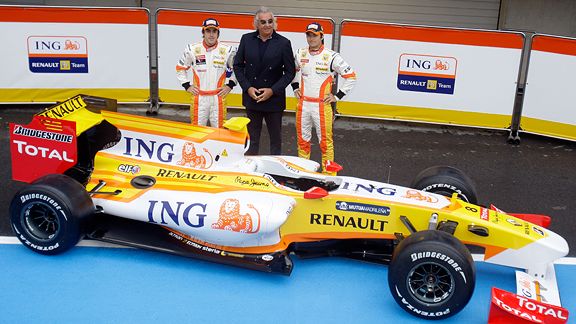
Renault team manager Flavio Briatore, center, and drivers Fernando Alonso and Nelson Piquet showcased the new R29 Monday in Portugal.
PORTIMAO, Portugal -- The Formula One teams and drivers are taking their first full-fledged steps into the unknown this week as they begin to come to grips with the new 2009 cars, which are considerably different from the 2008 models.
Six of the F1 teams have unveiled their new cars in recent days.
Ferrari started it off, showing its new F60 on Jan. 12 in Mugello, Italy. Three days later, Toyota's TF109 made its debut on the Internet. Then the McLaren Mercedes MP4-24 was shown to the media at McLaren's futuristic base in England on Friday.
The Renault R29 and the Williams Toyota FW31 made their debuts at the new Portimao track in the Algarve area south of the Portuguese capital of Lisbon on Monday, and the BMW Sauber F1.09 was launched in Valencia, Spain, on Tuesday.
McLaren, Renault, Williams and Toyota are testing their new cars this week in Portimao, along with Scuderia Toro Rosso's hybrid car.
BMW Sauber, meanwhile, is testing privately in Valencia. Ferrari was supposed to test in Portugal but switched venues to Mugello.
As reported earlier on ESPN.com, there have been a number of rule changes this year. Some of the first things that strike you about the new cars are the wide front wing, the narrow, high rear wing, and the absence of the plethora of aerodynamic tweaks on the bodywork and wings.
With the new cars barely completed before their first public showings, many of the drivers got their first looks at the machines at virtually the same time as the public and the media.
"I expected [the Ferrari F60] not to be as nice as we have always had," Felipe Massa said, comparing the new Ferrari to past models. "Although the regulations seem to make the car worse from a graphic point of view, I think the car is very nice.
"I hope it will be a fast car and a nice car -- I would always rather have an ugly car that was fast rather than a nice-looking car that was slow."
The new cars especially look different from a head-on view.
"I think it looks great," Heikki Kovalainen said of the McLaren MP4-24. "Whatever the regulations changes are, I think the team has managed to make a beautiful car."
Nelson Piquet gave the new Renault its first shakedown on a rainy day in Portugal.
"It feels great to be in the R29, even though the weather was not great," he said after his first day in the car. "Today was all about adding miles to the car, collecting data and learning as much as we could. Hopefully the rest of the week will allow us to build on the progress we have made today."
Piquet's teammate, two-time world champion Fernando Alonso, who slimmed down over the winter by doing plenty of bike riding, had yet to drive the new car. But when asked for his opinion of the Renault R29, he said that, like "all the 2009 cars, it is a little bit strange to see because of the rear wing and the front wing."
"But I like the car," Alonso added. "It does not matter if it is nice or not nice, it only matters if it is quick. And this we will find out in three or four weeks. But at the moment, I am happy with the work of the team, and we are all optimistic so far."
With the new rules banning mini wings, side deflectors, horns, flips, strakes, vanes, and the other aerodynamic bits and bobs, the 2009 cars look a lot cleaner than last year's models.
Kimi Raikkonen
AP Photo/Lorenzo GalassiKimi Raikkonen shook out the cobwebs recently on the F60, named as such for Ferrari's 60th year in F1.
"The look of the cars from the last two or three years, they were sorted out with nice detail," Toyota's Timo Glock said. "Now, when you see the car, you think they are missing something. But in the end, our car looks pretty nice.
"First of all, you have to deal with the front wing and rear wing. It looks a bit strange, but when 18, 20 cars are on the grid, everyone will get used to it. All the cars will look pretty similar as the regulations are pretty tight, so there isn't room for maneuver. But it is a bit strange to look at when you see it for the first time."
Tight as the regulations are, the teams already have found a few loopholes through which they can slide some aerodynamic tweaks.
"It's like weeds in a sidewalk crack," Renault's chassis technical director Bob Bell told ESPN.com. "If we can find the tiniest opening [in the regulations], we will take advantage of it."
Those wide front wings are going to result in more accidents and bent wings this season as the drivers get used to the new dimensions.
"The front wing is very, very wide this year," Toyota driver Jarno Trulli said. "Being wide means it's very easy to have contact with another car, and instead of wheel to wheel, you might have wing to wing."
Toyota test driver Kamui Kobayashi got the honor of turning the first laps in the TF109.
"I am happy with the new car," he said. "It has been an interesting experience to drive with [Kinetic Energy Recovery Systems] for the first time, and we are understanding more about the system all the time."
F1 supremo Bernie Ecclestone had this to say about the new generation of F1 cars:
"With fashion, you have to get used to things. I am pleased we have slicks again, but I don't like the small rear wings. But let's see if they do the job."
For racing purists, the return of slick tires that replace the ungainly looking, grooved, dry-weather tires F1 had used since 1998 is a welcome sight.
The drivers are happy about it, as well. Although they raced on slick tires in the lower categories, none of the current drivers except Trulli was around in F1 when slicks were last used. So this is something new for most of them.
"I think slicks are the right way to go," Kovalainen said. "It gives you a little bit more grip, especially in the slow speed corners."
The drivers who competed in F1's feeder series GP2 (and before that, F3000) have relatively recent experience with fast cars on slick tires, but only Glock (and Sebastien Bourdais, if he re-signs with Toro Rosso) has the combined experience of slick tires and high-powered single-seaters, thanks to his days in Champ Car.
However, Glock doesn't believe he will get any advantage from that.
"For us as drivers, we know what we have to do behind the steering wheel," he said. "Going back to slicks is easier than going from slicks to grooves. They are hard to understand. You learn with driving experience in karts and up to GP2, and then suddenly you have to go on grooved tires, so it makes it harder to understand the tires. Going to a tire that is easier to understand means no one will have a problem."
Lewis Hamilton
Hamilton
Lewis Hamilton is one of those who raced in GP2, and he thinks he will adapt quickly to F1 slick tires.
"I have always found I am quite good at learning and understanding with tires, and knowing how to use them," he said. "So I don't think I will be at a disadvantage."
Although the grip levels and the predictability of handling characteristics of the grooved tires improved over the years, the tires had a snap breakaway point that made it difficult for the drivers to find the limit of adhesion.
The drivers are going to be a lot busier in the cockpit this season, and they will have more input in the final performance output of the car.
This is for two main reasons: the introduction of Kinetic Energy Recovery Systems and the new adjustable front wing.
"If the systems will work at 100 percent," Ferrari team principal Stefano Domenicali said, "the drivers will have an extremely big delta performance, which will find its expression in tenths of a second."
KERS, which is optional, will allow the car to store energy created by the heat released from the brakes; the energy then will be on tap for the driver to use at his discretion. For as long as nearly seven seconds each lap, the driver can push a button for an 80-horsepower boost in power.
The drivers can do this in one 6.7-second spurt or in segments totaling 6.7 seconds. They are not allowed to store unused boost for the next lap.
So when is it best to use KERS? Obviously, drivers are going to use it off the starting line to try to get a jump on the cars around them. But after that, it becomes more complicated.
"Driver overload is going to be an issue this year," McLaren chairman Ron Dennis said. "There is an awful lot of functionality that is under the control of the driver, and this is going to be a challenge for the drivers to be able to cope with everything and get the best out of everything.
"It is not going to be, with KERS, as simple as pressing the button -- it will be a question of optimizing its use throughout a lap, not just on a straight."
Alonso quipped that the drivers should get paid more this year because of the extra work they will have to do.
Hopefully we don't have any reliability problems. We have been very, very fortunate in the past.
-- Lewis Hamilton
Like the other teams, McLaren has been working with its drivers at tests on just how and when to depress and hold the KERS power button.
"To get the most out of KERS, you have to deploy it as early as you can on the straight," McLaren chief engineer Tim Goss said. "As soon as the car comes out from being traction limited and power limited in the corner, then you want to deploy KERS."
McLaren gives the drivers a detailed chart showing how well they use KERS on each lap they test the system.
Massa says KERS will be used primarily to improve lap times and secondarily as a tool to protect the lead or pass a car in front.
"KERS is not made for overtaking; it is made for performance," he said. "So we will use it every lap. Especially if you are in front of somebody and the guy may be quicker than you. You will try to use it in every straight, which is maybe the only opportunity the other one has to pass you.
"If you are in front of somebody and you know you have maybe two overtaking opportunities on the track, you will use them on these parts because you know the guy can pass you there."
The other new addition that will keep drivers busy fiddling with levers and switches in the cockpit is the adjustable front wing. Twice each lap, a driver will be allowed to increase the angle of his front wing by 6 degrees.
This will be used to give a driver more downforce as he closes in on the car in front, which upsets the airflow to the wings of the car following.
"The idea is that when he comes in behind another car and starts to suffer any kind of wake effects, he can wind in a little more front wing and get a bit more front grip," McLaren senior aerodynamicists James Ingalls said. "And then as soon as he can successfully overtake, he can then reset the front wing to where it was before."
Operated by an electronic/hydraulic system, it will have a fail-safe mode so the wing will remain locked in one position should the switch gear fail. Thus there is a safety setting to prevent the flaps from flopping around.
A member of the video game generation, Hamilton is looking forward to driving the new-generation cars.
"I have a few other buttons to play with, which is more fun for me," he said. "I've always liked gadgets, so I have a few more devices I can play with.
"We don't really know to what effect the new controls will have, so for sure the team and the driver that gets on top of it more than the others will have a slight advantage. That is what we are working toward."
Kimi Raikkonen tried all the various 2009 systems in hodgepodge form on the 2008 test mule car and is looking forward to seeing how they all work together on the Ferrari F60 this week in Italy.
"These are the biggest changes for many years in F1," he said. "I don't have an idea how it will be all together. We have tried the tires, but it was last year's car. We tried to take the downforce off to get it more close to where it should be this year, but it is still not the same car, so with everything together, we should know better how it works. But it is interesting, and hopefully it will improve the racing, and that will be much better for all of us.
"For sure it will be difficult for the teams to get everything working well together. We don't have much testing before the season and no testing during the season. So it is up to the teams, and it will be whoever gets everything working and gets the best out of the package."
After the Williams FW31 made its debut, the team's technical director, Sam Michael, told ESPN.com that it is going to take several months before Williams knows how well its new car stacks up against the competition.
"I don't think we will know until the first four or five races," Michael said. "It has been the biggest change, particularly to the aerodynamics, since the 1980s. It has been a fascinating development period, and it is still continuing. Now for the first time, we are seeing what the other teams did with their cars."
Testing is always important, but that is especially the case this year because the cars are so different because of all the rule changes.
But preseason testing has been restricted. The teams are allowed only 20 test days between the beginning of the year and the first race.
Hamilton, for example, will get only a few days in the new MP4-24 before the season opener in Australia on March 29.
"I have, like, only seven days in the car," he said, "and so we are going to make sure that we really extract the most from those days. Hopefully we don't have any reliability problems. We have been very, very fortunate in the past. In two years, we have not had any reliability problems, so I am confident the team have done a great job."
And with testing being banned during the season, the drivers will be spending more time in the driving simulators and more time discussing things with their engineers as they try to extract every last ounce of performance from the new systems and new cars.
Plus, the cars and their components will spend more time on testing rigs in the teams' factories.
Still, it is hard to beat good old-fashioned track time.
"If you don't have everything under control by the last test of the winter, there is no more time to do anything," Alonso said. "If the KERS is still not working by the last test, it is better that you remove the system and race without for the rest of the season.
"You cannot arrive on the Friday in Malaysia or Bahrain and think about testing a new solution for the KERS. It is too late."
James Blake took the necessary time off to recuperate from a wearisome 2008 season.
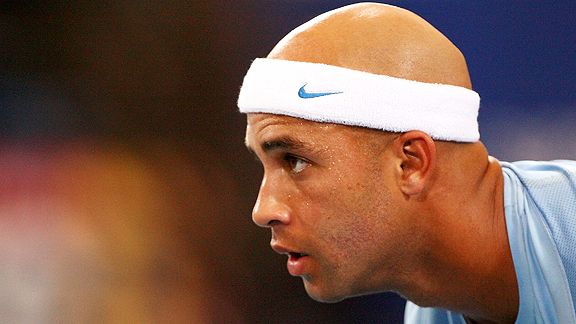
SYDNEY, Australia -- James Blake often says that he learns as much, if not more, from a loss as a win. Usually he tries to apply those lessons in his very next match.
In this instance, though, he waited 12 months. Blake, the two-time defending champion in Sydney last year, lost disappointingly in the first round. He flew to Melbourne, made the most of his extra practice time and proceeded to have his best-ever performance at the Australian Open, reaching the quarterfinals before falling to Roger Federer.
This year, Blake decided to mimic the conditions, minus the loss. He logged some match time in the exhibition Hopman Cup in the western Australian capital of Perth, then went directly to Melbourne for 10 days of structured training with his coach, Brian Barker.
"This is to tailor-make the preparation," Blake said by phone from Melbourne. "Sydney's great, and I have played well there in the past, but I felt like I couldn't plan the way the days would go. You never know if a match is going to be short or long. This time I know exactly when I'm going to have long days and when I'm going to rest up."
Rest became Blake's watchword late last season when he hit a wall after almost four years without a significant break. He played into December 2007 with the victorious U.S. Davis Cup team, and that season melted into the next, with its condensed schedule dictated by the Olympics. By the time the U.S. Open rolled around, Blake was burned out and unable to muster his usual energy level for his favorite tournament. He would finish 2008 without a tournament title for the first time in four years.
Barker said Blake's long journey back from serious injury and illness in 2004, followed by a sustained period in the top 10, finally caught up with him.
"Most top players, including James, think they can keep doing more and more and always handle what's in front of them," Barker said. "When you're happy to be alive and happy to be healthy and happy to be playing some of the best tennis you've ever played, you're not going to be really excited to take a break. I was going to talk to him about it, but he brought it up to me first."
Blake took September off, bowing out of the Davis Cup semifinals in Spain, and played just seven matches down the stretch. Now he's set to attack the first Grand Slam of the season with fresh legs, a refreshed mind and a new apparel sponsor. After spending 10 years -- his entire professional career -- with Nike, Blake signed with Fila and is starting a co-branded clothing line that will include tennis, golf and casual sportswear.
Blake's new duds for Australia will be white and Carolina blue, a natural choice given his longtime admiration of Michael Jordan. And like No. 1 Rafael Nadal, Blake is abandoning his trademark sleeveless look this season. "I'm even wearing a collar," he said. "Guess I'm getting older."
Having carefully planned his lead-up to the season's first Grand Slam, Blake still doesn't know who his first opponent will be. He drew a qualifier, and might be happy about that relative breather later on, as his quarter includes last year's finalist and one of this year's favorites, Jo-Wilfried Tsonga of France, and Great Britain's Andy Murray.
Federer recently voiced an idea that has been kicking around the players' lounge for some years, proposing that the Australian Open be scheduled a couple of weeks later so players would have more time to warm up for it. Blake said he can see the value in that, but added that he understands the tournament's position, too.
"It would definitely be better for the players if it was later, but then the kids are back in school and people aren't on holiday," he said. "The Australian is unique. It's a real test of who's done the hard work in the offseason, who's fit and who's working their way in."
One small drawback of being in the Southern Hemisphere next week is that Blake will miss the Jan. 20 inauguration of President-elect Barack Obama, with whom he shares two significant experiences: growing up in a mixed-race family and seeing his autobiography become a best-seller.
One of Blake's freshman-year roommates at Harvard, Peter Gage, is director of the inaugural parade. Another friend actually scored one of the coveted tickets to the ceremony for Blake, "but the job gets in the way, and I'm glad to have a job," he said.
Blake appeared at two Obama fundraisers during the campaign but has not met the new president, who is reportedly a serious tennis fan and appreciates Blake in particular.
The 29-year-old watched the election returns at home in Connecticut with his mother and a few close friends. His wider circle of friends, who knew how much Obama's victory meant to him, besieged him with text messages and phone calls when the results became official. "It's a time of a ton of expectations and great opportunities," Blake said.
Blake carried Obama's first book, "Dreams From My Father," in his tennis bag last spring and said he found Obama's account of his youthful search for identity moving and note-perfect.
"It made it really easy to read," Blake said. "I got the feeling that he felt the same way as I did. As you're growing up, you don't notice you're different until people start forcing you to notice. You feel normal until someone tells you you're not. … My parents always told me there was nothing different about me, nothing wrong, that I was just as good as the next person."
RECRUITING INSIDER
Joel Casamayor TKO10 Michael Katsidis, March 22 at Cabazon, Calif.
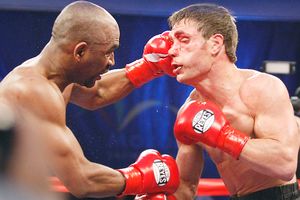
If Katsidis is on the card, you can pretty much be assured a slugfest. But folks had their doubts about the quality of this bout because Casamayor, defending the lineal lightweight championship, had looked awful in his previous fight and had been known to stink out his opponents. So the sheer thrills and drama of this slugfest came as a surprise. It started fast, with Casamayor dropping Katsidis twice in the first round, and the excitement never let up. Katsidis fought his way back into the bout and was beginning to wear down Casamayor, who was then knocked out of the ring and onto the apron by a body shot in the sixth round. Katsidis led on two scorecards heading into the 10th when Casamayor knocked him down with a left Katsidis never saw. With his big heart Katsidis continued, but after he ate another flush shot referee Jon Schorle called off the exhilarating bout and Katsidis suffered his first defeat. Moments after the stoppage, HBO's Kellerman summed it up perfectly: "What a shocking turn of events," he said. "When it looked like, by the fourth or fifth round, that Katsidis was beating the fight out of Casamayor, that the script was being written that the young, new fighter on the scene was going to emerge as lightweight champion -- for the old lion to pull off that kind of knockout was incredible."
Tomasz Adamek W12 Steve Cunningham, Dec. 11 at Newark, N.J.
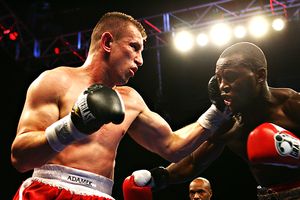
On paper, the cruiserweight world championship fight figured to be an excellent one given the boxers' contrasting styles. But who could have expected a late-year epic, the greatest fight in the brief history of Versus-televised boxing and a title bout that ranked not far behind the first Evander Holyfield-Dwight Muhammad Qawi battle as the division's most exciting fight? Adamek earned the split-decision victory on the strength of three knockdowns (in the second, fourth and eighth rounds), but Cunningham dished out tremendous punishment of his own -- including the all-action fourth, when he battered the iron-chinned Adamek for nearly the entire round before getting clipped and going down late. For 12 rounds, there was terrific ebb and flow and loads of furious exchanges.
Manny Pacquiao W12 Juan Manuel Marquez II, March 15 at Las Vegas
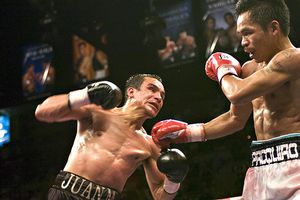
Almost four years after their epic draw for the featherweight championship, Pacquiao and Marquez finally met again in a junior lightweight championship bout and delivered a sensational fight. The showdown between two of the top pound-for-pound fighters in the world had everything fans could have hoped for. Simply put, it was another tremendous battle filled with skill and will, blood and heart. As the ninth round came to a close, HBO's Lampley exclaimed, "They trade shots. What a war! Both men trying desperately to win the round!" But the truth is, it went like that all night. In the end, the controversial split decision could have gone either way, but the outcome didn't spoil the spectacle. There was blazing action throughout, and all but two rounds were tightly contested -- the third, in which Pacquiao nailed Marquez with a left hand to knock him down, and Marquez's big 12th round.
Antonio Margarito TKO11 Miguel Cotto, July 26 at Las Vegas
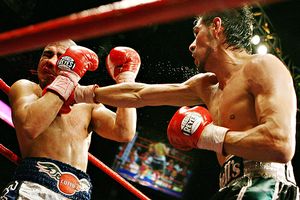
Of all the national rivalries in boxing, few generate as much passion as Mexico versus Puerto Rico, and this awe-inspiring fight took its place among the rivalry's greatest bouts. From the moment the welterweight title fight was signed until the moment Cotto took a knee for the second time under a heavy assault in the 11th round -- with his uncle and trainer, Evangelista Cotto, throwing in the towel to finish it -- the fight surpassed the considerable expectations heaped upon it. "That is a modern boxing classic," HBO's Max Kellerman gushed at the fight's conclusion. Although Margarito landed shots early, the faster Cotto stayed in control and outboxed him in a fast-paced fight. But the granite-chinned Margarito, with his relentless pressure, walked Cotto down, seemingly turning the tide in the sixth round. Bleeding from his mouth and nose, Cotto was beginning to fade until finally taking that second knee under a hail of blows for his first defeat. With both eyes swollen, Margarito was smiling nonetheless after winning one of the most anticipated, and subsequently best, fights of the year. "An epic fight with an epic conclusion," HBO's Jim Lampley said moments after the stoppage. "The first loss of Cotto's career and another triumph for Mexico in the ongoing war with Puerto Rico." It was the sort of fight that makes putting up with all the political nonsense in boxing tolerable -- because every now and then you get to watch something truly special.
Israel Vazquez, right, was bloodied, but Rafael Marquez was beaten in the fighters' epic third meeting.
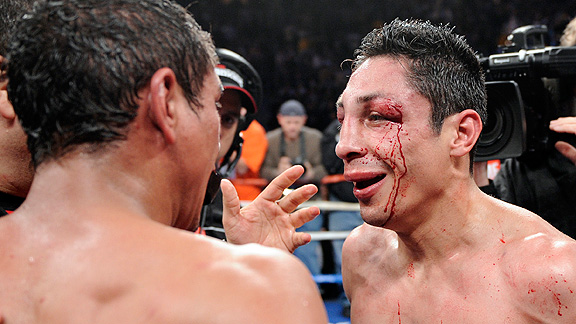
Israel Vazquez and Rafael Marquez had already etched their names in boxing history with their back-to-back junior featherweight wars in 2007.
Marquez, the former bantamweight champion, had moved up in weight to challenge Vazquez for the title in their first explosive confrontation in March and won the fight of the year candidate via seventh-round TKO when Vazquez could not continue because of a serious nose injury. Had the fighters not faced each other again in 2007, the bout might have stood the test of time as the year's best.
Five months later, however, their August rematch trumped the first fight. This time, Vazquez regained the title via sixth-round knockout in a battle that was even more sensational, ferocious and action-packed than the first installment. It was universally hailed as the fight of the year.
Rafael's Fights of the Year
Year Fight
2008 Israel Vazquez W12 Rafael Marquez (III)
2007 Israel Vazquez TKO6 Rafael Marquez (II)
2006 Somsak Sithchatchawal TKO10 Mahyar Monshipour
2005 Diego Corrales TKO10 Jose Luis Castillo (I)
2004 Marco Antonio Barrera W12 Erik Morales (III)
2003 Arturo Gatti W10 Micky Ward (III)
2002 Micky Ward W10 Arturo Gatti (I)
2001 Micky Ward W10 Emanuel Burton
2000 Felix Trinidad TKO12 Fernando Vargas
Fans were bracing for another hot fight when Vazquez and Marquez met again on March 1, 2008 at the Home Depot Center in Carson, Calif., the site of their first bout almost one year to the day earlier. At the top of telecast, Showtime's Steve Albert set the stage.
"If the tiebreaker between Israel Vazquez and Rafael Marquez turns out to be the fight of the year, it won't surprise a single boxing fan," Albert said. "That's because Vazquez-Marquez I and II were bloody and brutal battles that featured power punching, knockdowns, changes in momentum and the highest level of skills."
So how could the rubber match possibly meet the incredibly high standard set by the first two encounters? It seemed impossible, yet the Mexican stars found a way to exceed every expectation by delivering an extraordinary battle for the ages, a bout that had all of the drama, excitement, blood, heart and skill of their first two fights -- and then some -- not to mention so many more rounds of sustained action.
In the end, it was Vazquez who sealed the razor-thin split-decision victory on the strength of a 12th-round knockdown seconds before the final bell, allowing him to hang on to the 122-pound world championship in an electrifying give-and-take thriller.
The instant classic was a raging battle with blistering action throughout, and it placed the Vazquez-Marquez rivalry into the pantheon of boxing's greatest trilogies alongside such famous pairings as Muhammad Ali-Joe Frazier, Evander Holyfield-Riddick Bowe, Tony Zale-Rocky Graziano, Marco Antonio Barrera-Erik Morales and Arturo Gatti-Micky Ward.
Is it any surprise, then, that Vazquez-Marquez III was also the clear choice as the 2008 ESPN.com Fight of the Year?
From the opening round, when the fighters began to trade furiously, you could sense it was going to be another special fight. After one big exchange, Albert had the feeling, too. "Here we go again," he said.
Marquez appeared to take the early rounds, including the fourth, which proved to be a round of the year candidate. Marquez dropped Vazquez in the round, but he was rocked himself later in the frame.
Back and forth they went all night, although Vazquez was narrowing the scores through the middle rounds and Marquez was docked a point for a low blow in the 10th after receiving multiple warnings from referee Pat Russell.
It all set the stage for an epic finish. Sensing correctly that he needed the 12th round, Vazquez was all over Marquez in the bruising stanza. Finally, with seconds remaining, Vazquez sent Marquez staggering into the ropes, which kept him from going down, and Russell calmly and rightfully ruled it a knockdown just before the final bell.
"This crowd was treated, as we all were, to a very special night of boxing," Showtime's Al Bernstein said as the crowd cheered.
What made it so special, besides the awesome action, is that unlike most trilogies, each of the Vazquez-Marquez fights, which came uninterrupted by other bouts for either man, exceeded the previous fight. That is unheard of.
"The historical significance of the trilogy is still sinking in," Vazquez said a month after the fight. "None of us will know the true impact until several years from now, but I truly believe that this trilogy will stand the test of time. I think it will be remembered for many, many years."
Sri Lanka Scramble Home To Final Victory
South Africa Go 1-0 Up With Final Over Win
Mumbai Take 38th Ranji Trophy Victory
West Indies Name 'A' SideTo Face England
Pakistan v Sri Lanka, 1st ODI,
Russia bid for World Cup
Subscribe to:
Comments (Atom)















